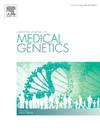Oxford Nanopore long-read sequencing with CRISPR/Cas9-mediated target selection for accurate characterization of copy number variants in the LDLR gene
IF 1.7
4区 医学
Q3 GENETICS & HEREDITY
引用次数: 0
Abstract
Introduction
Familial hypercholesterolemia (FH) affects around 1 in 250 people. Most FH cases are caused by pathogenic LDLR variants, with copy number variations (CNVs) accounting for about 10 %. However, short-read gene panel sequencing and multiplex ligation-dependent probe amplification (MLPA) are limited in the specification of CNV breakpoints and the identification of complex structural variants (SVs).
Materials and methods
We designed crRNAs for Cas9-mediated target selection of LDLR and performed long-read sequencing (LRS) on an Oxford Nanopore MinION device using high-molecular-weight (HMW) DNA or DNA from standard purification. After establishing the LRS approach, we characterized two known LDLR CNVs and tested two individuals with strong clinical evidence of FH but no pathogenic variant in short-read gene panel sequencing.
Results
Complete coverage of LDLR was achieved for both HMW DNA and DNA from standard purification. LRS allowed us to specify CNV breakpoints and showed that the known LDLR deletion is 19.2 kb in size encompassing exons 1–2 and the 5′-untranslated and promoter regions. Furthermore, LRS verified the in tandem localization of a large LDLR duplication covering exons 4–8. Both CNVs were classified as loss-of-function. Moreover, breakpoint information enabled confirmatory analysis by PCR and Sanger sequencing for both CNVs. No SVs were detected in two apparently mutation-negative FH probands using our approach.
Conclusions
Nanopore LRS with CRISPR/Cas9-mediated target selection allows for accurate characterization of CNVs and can therefore serve as a complementary method to short-read sequencing-based FH diagnostics by facilitating variant interpretation and enabling cost-effective PCR-based variant confirmation in subsequent familial analyses.
牛津纳米孔长读测序与CRISPR/ cas9介导的靶标选择准确表征LDLR基因拷贝数变异。
简介:家族性高胆固醇血症(FH)影响约1 / 250人。大多数FH病例是由致病性LDLR变异引起的,拷贝数变异(CNVs)约占10%。然而,短读基因面板测序和多重连接依赖探针扩增(MLPA)在确定CNV断点和识别复杂结构变异(SVs)方面受到限制。材料和方法:我们设计了用于cas9介导的LDLR靶标选择的crrna,并使用高分子量(HMW) DNA或标准纯化DNA在Oxford Nanopore MinION设备上进行长读测序(LRS)。在建立LRS方法后,我们鉴定了两个已知的LDLR CNVs,并在短读基因面板测序中检测了两个具有FH临床证据但没有致病变异的个体。结果:HMW DNA和标准纯化的DNA都实现了LDLR的完全覆盖。LRS允许我们指定CNV断点,并显示已知的LDLR缺失大小为19.2 kb,包括外显子1-2和5'-未翻译区和启动子区。此外,LRS验证了覆盖外显子4-8的大型LDLR重复的串联定位。两种CNVs都被归类为功能丧失。此外,断点信息可以通过PCR和Sanger测序对两个CNVs进行验证性分析。我们的方法在两个明显突变阴性的FH先证中未检测到SVs。结论:纳米孔LRS与CRISPR/ cas9介导的靶标选择允许准确表征CNVs,因此可以作为基于短读测序的FH诊断的补充方法,促进变异解释,并在随后的家族分析中实现成本效益高的基于pcr的变异确认。
本文章由计算机程序翻译,如有差异,请以英文原文为准。
求助全文
约1分钟内获得全文
求助全文
来源期刊
CiteScore
4.10
自引率
0.00%
发文量
193
审稿时长
66 days
期刊介绍:
The European Journal of Medical Genetics (EJMG) is a peer-reviewed journal that publishes articles in English on various aspects of human and medical genetics and of the genetics of experimental models.
Original clinical and experimental research articles, short clinical reports, review articles and letters to the editor are welcome on topics such as :
• Dysmorphology and syndrome delineation
• Molecular genetics and molecular cytogenetics of inherited disorders
• Clinical applications of genomics and nextgen sequencing technologies
• Syndromal cancer genetics
• Behavioral genetics
• Community genetics
• Fetal pathology and prenatal diagnosis
• Genetic counseling.

 求助内容:
求助内容: 应助结果提醒方式:
应助结果提醒方式:


